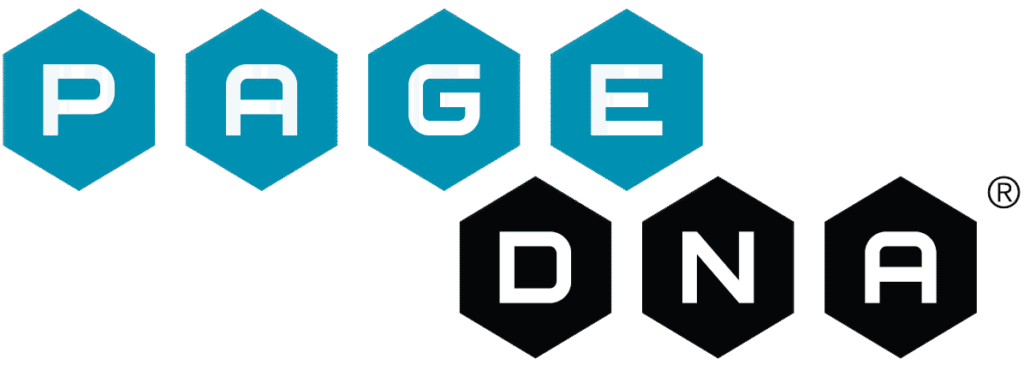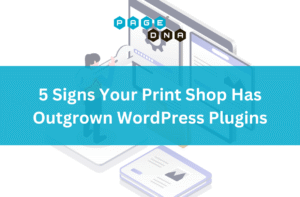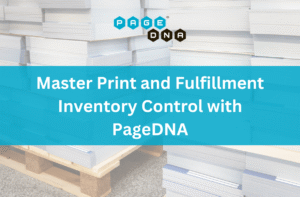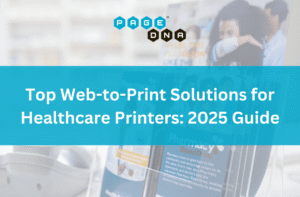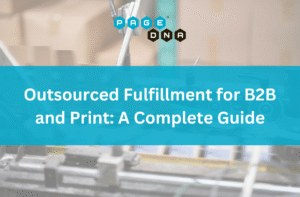In the fast-paced world of print and promotional product distribution, efficiency is everything. Yet, many distributors find themselves bogged down by a silent killer of productivity: manual workflows.
Picture this: a sales representative spends hours each day deciphering handwritten orders, manually entering data into spreadsheets, getting quotes from vendors, sending orders to those vendors, and chasing down approvals via email. This scenario, all too common in the industry, is not just inefficient; it’s a major roadblock to growth and profitability.
The reliance on outdated, manual processes creates a cascade of problems:
- Costly errors and frustrating delays
- Strained customer relationships
- Employee burnout and high turnover
- Limited scalability and growth potential
But there is a better way. By embracing print and promo workflow automation, distributors can break free from the shackles of manual tasks, streamline their operations, and pave the way for sustainable success.
The High Cost of Manual Workflows in Print and Promotional Product Distribution
The hidden costs of manual workflows can be staggering, impacting every aspect of a print distributor’s business. These inefficiencies are not just minor annoyances, they are significant drains on time, resources, and morale.
Time-Consuming Order Entry
The process of manually transcribing orders from emails, phone calls, and even faxes is a recipe for disaster. Consider the typical workflow:
- Email orders: Sales reps spend 2-3 hours daily copying information from emails into order systems
- Phone orders: Critical details get lost in translation, requiring multiple callbacks
- Fax orders: Illegible handwriting leads to guesswork and errors
- Vendor management: Multiple vendors create surface area, tracking and data inconsistencies
This manual data entry is a non-value-added activity that consumes countless hours that could be better spent on sales, customer service, or strategic planning.
Error-Prone Quoting and Invoicing
Manual quoting presents several critical challenges:
Common Quoting Problems:
- Calculation errors: Manual math leads to underpricing or overpricing
- Outdated pricing: Using old rate cards results in margin erosion
- Inconsistent quotes: Different reps quote differently for similar jobs
- Time delays: Complex quotes take hours or days to prepare
The invoicing process is equally fraught with challenges. Manually creating, sending, and tracking invoices is a time-consuming administrative burden that can lead to cash flow problems and billing disputes.
Inefficient Job Submission to Production
The handoff from sales to production is a critical stage in the ordering workflow, and it’s often where manual processes break down completely.
Typical Production Handoff Issues:
- Multiple email chains with confusing instructions
- Missing or incorrect file specifications
- Preflighting issues discovered too late
- No standardized job ticket system
- Communication breakdowns between departments and vendors
This lack of a standardized, automated process creates bottlenecks, slows down production, and increases the likelihood of costly errors.
Lack of Real-Time Visibility
In a manual workflow, it’s nearly impossible to track the status of a job in real-time. Sales representatives and CSRs are often left in the dark, unable to provide their customers with accurate updates.
The Visibility Problem:
- No centralized job tracking system
- Status updates require phone calls or emails
- Customer inquiries create additional work
- Reactive problem-solving instead of proactive management
- Lost jobs and missed deadlines
This lack of visibility leads to a reactive approach to problem-solving, where issues are only addressed after they have already caused a delay or a customer complaint.
How Manual Workflows Impact Business Growth and Profitability
The cumulative effect of these daily inefficiencies is a significant drag on a print distributor’s ability to grow and prosper.
Reduced Profit Margins
Every manual touchpoint adds cost to a print or promotional product job:
Cost Factor | Impact |
|---|---|
Manual data entry | 15-20 minutes per order |
Error corrections | 2-3 hours per mistake |
Rush shipping | 25-50% premium costs |
Reprints | 100% material cost loss |
Administrative overhead | 20-30% of total job cost |
In a competitive industry like print and promotional product distribution, these inefficiencies can be the difference between profitability and loss.
Strained Customer Relationships
Modern customers expect a seamless, efficient ordering experience. Manual workflows create multiple friction points:
- Slow response times: Quotes take days instead of minutes
- Communication gaps: Customers can’t track their orders
- Quality issues: Errors damage trust and credibility
- Inconsistent service: Experience varies by sales rep
When customers can’t get accurate quotes quickly, can’t track their orders in real-time, and receive jobs that are incorrect or late, their trust in the distributor is eroded.
Limited Scalability
A business that relies on manual workflows is a business that cannot scale effectively. As order volume increases, the manual processes become overwhelmed:
The Scalability Problem:
- Linear growth only: More orders = more staff needed
- Quality degradation: Rushed work leads to more errors
- Capacity constraints: Physical limits on manual processing
- Training bottlenecks: New staff require extensive training
The only way to handle more orders is to hire more people, which further increases costs and complexity without improving efficiency.
The Solution: Embracing Print and Promotional Product Workflow Automation with PageDNA
The answer to the struggles of manual workflows is not to work harder, but to work smarter. By embracing print workflow automation with a dedicated platform like PageDNA’s commercial print solutions, distributors can transform their operations and unlock their full potential.
Introducing Web-to-Print Technology
A web-to-print platform serves as a centralized, online hub for all of a distributor’s printing needs. It provides a seamless, self-service experience for customers while automating the entire workflow from order entry to delivery.
Key Web-to-Print Benefits:
- 24/7 availability: Customers can place orders anytime
- Instant quoting: Real-time pricing calculations
- Automated workflows: Reduced manual intervention between you and your vendors
- Centralized management: Single source of truth for all orders
Automated Order Entry and Job Submission
With PageDNA, customers can place their orders directly through a branded, user-friendly storefront. The platform can be configured with:
Advanced Automation Features:
- Pre-approved templates: Ensure brand consistency
- Product catalogs: Streamlined ordering process
- Automatic job tickets: Generated instantly upon order
- Production routing: Jobs sent to appropriate vendor, or held for quote
- File validation: Automated preflighting and quality checks
This automation eliminates the need for manual data entry and reduces the risk of errors by up to 95%.
Dynamic Quoting and Integrated Billing
PageDNA’s powerful quoting engine can handle even the most complex print jobs, providing customers with instant, accurate quotes. The platform also streamlines the billing process with support for:
- Multiple payment options: Credit cards, purchase orders, cost centers
- Automated invoicing: Generated upon job completion
- Payment tracking: Real-time payment status updates
- Tax calculations: Automatic sales tax computation
- Discount management: Volume and customer-specific pricing
Centralized Job Tracking and Reporting
The PageDNA Order Manager provides real-time visibility into the status of every job, from order entry to delivery. This comprehensive reporting system offers:
Tracking and Reporting Features:
- Real-time status updates: Live job progress tracking
- Customer portals: Self-service order status checking
- Automated notifications: Email updates at key milestones
- Performance analytics: Detailed business intelligence
- Custom reports: Tailored to specific business needs
Sales representatives can proactively manage their orders and provide customers with accurate updates, while management gains valuable insights into sales, production, and customer behavior.
Seamless Integration Capabilities
PageDNA is designed to integrate with a distributor’s existing business systems, creating a truly end-to-end automated workflow. Integration options include:
- MIS systems: Management Information Systems
- ERP software: Enterprise Resource Planning
- Accounting platforms: QuickBooks, Sage, and others
- CRM systems: Customer relationship management
- Shipping platforms: FedEx, UPS, USPS integration
According to UiPath’s research on business process automation, companies that implement comprehensive workflow automation see an average ROI of 30-40% within the first year.
Real-World Success: The Transformation Impact
Consider the transformation experienced by distributors who have implemented automated workflows:
Before Automation:
- 40+ hours weekly spent on manual order entry
- 15-20% error rate requiring reprints and corrections
- 3-5 day quote turnaround time
- Limited visibility into job status
- Customer complaints about communication gaps
After PageDNA Implementation:
- 90% reduction in manual data entry time
- Less than 2% error rate
- Instant quotes for standard products
- Real-time job tracking and updates
- 95% customer satisfaction improvement
The Strategic Advantage of Automation
Modern print distributors who embrace automation gain significant competitive advantages:
Operational Excellence:
- Faster turnaround times: Automated workflows eliminate bottlenecks
- Higher accuracy: Reduced human error through systematic processes
- Scalable operations: Handle more volume without proportional staff increases
- Cost efficiency: Lower operational costs per job
Customer Experience:
- Self-service capabilities: Customers can place orders 24/7
- Transparent communication: Real-time status updates
- Consistent quality: Standardized processes ensure reliability
- Faster response times: Instant quotes and confirmations
Business Growth:
- Market expansion: Serve more customers effectively
- Service diversification: Offer new products and services
- Competitive pricing: Lower costs enable better pricing
- Strategic focus: Management time freed for growth initiatives
Conclusion
The struggles of print and promotional product distributors with manual workflows are real and significant. They represent a drain on profitability, a barrier to growth, and a source of frustration for both customers and employees. However, these challenges are not insurmountable.
By embracing print workflow automation with a dedicated platform like PageDNA, distributors can:
- Eliminate inefficiencies that drain time and resources
- Reduce costs through automated processes
- Improve customer satisfaction with better service
- Create a foundation for sustainable growth
The future of print distribution belongs to those who are willing to leave the manual past behind and embrace the automated future. The question isn’t whether to automate, it’s how quickly you can implement the systems that will transform your business.
As noted by industry experts at WhatTheyThink, print businesses that fail to adopt modern workflow automation risk being left behind by more agile competitors who can deliver better service at lower costs.
Frequently Asked Questions
What is the biggest challenge for print distributors today?
The biggest challenge for print distributors today is overcoming the inefficiencies of manual workflows. These outdated processes lead to errors, delays, and high operational costs, making it difficult to compete in a fast-paced market where customers expect instant quotes, real-time tracking, and consistent quality.
How can automation help my print distribution business?
Automation can help your print distribution business by streamlining your entire workflow, from order entry and quoting to production and billing. This reduces errors by up to 95%, saves 30-40 hours per week on manual tasks, lowers operational costs, and improves customer satisfaction through faster, more reliable service.
Is web-to-print difficult to implement?
While the idea of implementing a new system can be daunting, modern web-to-print platforms like PageDNA are designed for easy implementation. PageDNA offers a guided implementation process with an average timeline of 49 days, plus a dedicated support team to ensure a smooth transition with minimal business disruption.
How does PageDNA handle complex print orders?
PageDNA is built to handle the complexities of the print industry. Its powerful platform supports variable data printing, complex pricing rules with multiple variables, finishing options, shipping calculations, and a wide range of customization options, making it easy to manage even the most complex print jobs while maintaining accuracy and efficiency.
Can PageDNA integrate with my existing software?
Yes, PageDNA is designed to integrate with a wide range of business systems, including MIS (Management Information Systems), ERP (Enterprise Resource Planning), accounting software like QuickBooks, CRM systems, and shipping platforms. This creates a seamless, end-to-end workflow and eliminates the need for manual data entry between systems, further reducing errors and saving time.
